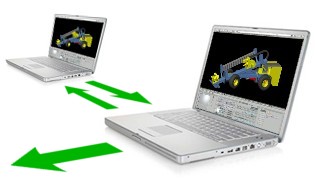Open collaborative design
Open design takes the open source software development model and applies it to the design of physical artifacts and systems. Open source is now very prominent in the world of software creation. In this model networks of people connected by the internet collaborate to evolve software and make it freely available to others. Not only is the product available to use, but so are the workings of the software known as the source code. Anyone can customize and improve open-source software, making these changes available to others potentially allowing rapid development times and robustness.
Contents
Beyond software
This methodology is not limited to software. A noteable example beyond software are 'open content' projects such as Wikipedia, the well known collaborative encyclopedia which is accessible and editable by anyone with a web browser. Started in 2001 it is now the largest encyclopedia in the world, grown organically from thousands of users, and the overall quality of articles is surprisingly good. [1]
With a few built-in mechanisms to make sure the project doesn't dissolve into total chaos, the result is that this pool of knowledge is assembled and edited by people who want to do it. No-one is paying them to do it and no-one is telling them to do it, they do it because they want to. It feels like the right thing to do - they are contributing to something greater. Contributors' know their efforts will be used and appreciated by thousands of other people.
Applying Open Source methodology to the physical world
There is no reason why open source development methods cannot be applied to machines and systems in the physical world too. The simplest method is to share information through a website on how to make things using text, diagrams and photographs. A more sophisticated way to collaborate on complex machinery and products would be to share CAD assemblies over the internet much like project teams do in engineering and product design companies, knitted together with supporting information in an open and freely structured environment, much like a wiki.
There are certain barriers to overcome for open design when compared to software development where there are mature and widely used tools available and the duplication and distribution of code cost next to nothing. Creating, testing and modifying physical designs is not quite so straightforward because of the effort and time required to create the physical artifact.
Suitable CAD software
It is likely that at some point advanced open-source CAD software with built-in physics engines and the ability to model kinematics will aid engineers and designers greatly in this respect by allowing a lot of testing to be done virtually. So the availability of user-friendly open source CAD software will be essential to this field along with open standards for associated file formats, as well as file converters to extract data from files created with proprietary CAD packages.
Methods of turning collaborative designs into real objects
Of course to be useful to anyone these designs need to turned into physical objects which unfortunately isn't quite as straightforward as compiling software or downloading it over the internet. Here are some different methods that might be used to give a design physical form:
Get your hands dirty
- Craft the item yourself or in a group according to plans using your own skills plus readily available components and perhaps some specially ordered custom parts.
Mail order machining
- Small-scale engineering firms that will make custom items to order have always been around, often specialising certain materials and techniques, and a company called eMachineShop takes custom fabrication a step further in terms of ease of use for the individual. The US-based company supply a free CAD software package that enables you to design your part and then it checks if it is possible to create bearing in mind the machining processes available.
- It calculates the price when the design process is finished, then the order is sent electronically and when the parts have been made up they are shipped by post (internationally if required). They say they can handle part quantities from one offs to runs up to a million.
Fab Labs
- Fab Labs (fabrication laboratories) are small scale workshops with modern computer controlled equipment such as laser cutters, CNC machines, injection moulding machines and circuit board printing giving the ability within one room to create just about anything from engines to electronic devices. The concept has been developed at the Center for Bits and Atoms at MIT, and they have helped set up nine Fab Labs around the world so far - see a list of them at http://fab.cba.mit.edu.
Rapid prototyping machines
- Rapid prototypers or 3D printers are widely used in industry for creating solid three dimmensional objects straight from CAD models. Currently there are various limitations with these machines but in the near future the price will reduce rapidly, the number of different materials that can be used to make parts will multiply, the resolution will become steadily finer and the build-speed will increase. It is anticipated that these machines will soon be within the reach of ordinary people following a similar evolutionary path to computer printers. Mail order rapid prototyping services are currently available.
- For further info see the rapid prototyping machines page.
Contract manufacturing facilities
- A large group of people all wanting the same item made could sent the details of the design to a large-scale contract manufacturing and assembly company to make use of specialist facilites and economies of scale. This would be akin to having the products made at cost price, without the markups involved when buying proprietary goods - relating to intellectual property, distribution, retail, other middlemen and general profit margins.
Products of a fully automated economy
- For an explanation of this possibility, see automated economy section of advanced automation page.
